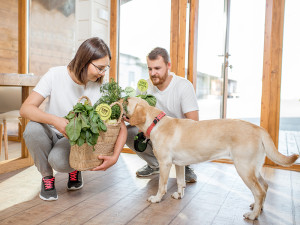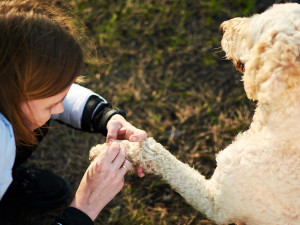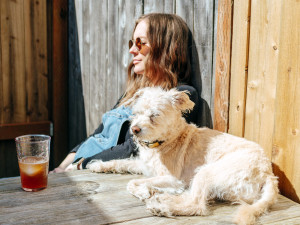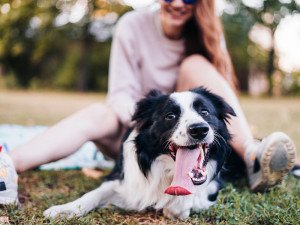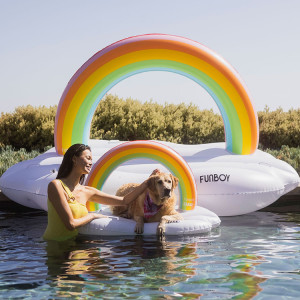9 Warm Weather Hazards for Dogs—And How to Keep Your Pup Safe All Summer
So you both can have the best time ever.

Share Article
Memorial Day (aka the unofficial start of summer) has passed, and now we have the whole season ahead of us. Beaches, hiking, lake hangs, barbecues, and a built-in excuse to order the piña colada (the excuse being, “That looks good, and it’s hot outside”) await — all with our pets by our side.
There are two sides to every coin, though, and summer comes with its fair share of dangers for our dogs. We don’t mean to put a damper on your excitement, but taking a moment to prepare for the biggest hazards of the hot months will, in the end, help you and your pup maximize your summer fun. These are some of the most common dangers your pup may encounter this season.
Pets — they have allergies, too.
You’re probably already well aware of this nuisance to your own life. Pollen spares no creatures on this great green earth of ours. It can come for us all whether we live in rural, suburban, or urban environments, and, yes, it also comes for dogs. Grasses and other airborne irritants tend to explode beginning in the spring and peak in April, May, or June depending on where in the Northern Hemisphere you live.
The good news is that allergies are almost never life-threatening. Dogs can experience discomfort, though, so keep an eye out for symptoms. Allergies may show up as sneezing attacks, crusty eyes, and excessive itching. Take your pup to the vet if they can’t stop scratching, their sleep is disrupted, or they look generally miserable.

Veterinarian Dr. Stephanie Liff, the medical director and owner of Pure Paws Vet Careopens in new tab in Brooklyn and New York City, recommends a HEPA filter for your air conditioner to help mitigate a dog’s experience with allergies. If you live in an apartment building, ask your management to turn filters over.
“I think people have a misconception that allergies are worse in the suburbs, but urban allergens are pretty prevalent,” Dr. Liff says. “And because people live in high rises where you don’t have full autonomy over your air, it can be even more problematic.”
She adds that, regardless of where you live, wiping down dogs or bathing them post-walk can help reduce the irritant, and adding fish oil to their diet to improve their skin barrier can make them more resilient to these particular elements. Another simple tip: If your dog can tolerate it, putting vaseline on their nose can help catch the allergens before they settle into the nose canal.
And, finally, some good news: One thing you don’t have to worry about on behalf of your outdoor-loving dog? Poison ivy; it just doesn’t affect them like it affects humans.
Gardeners beware
Many plants, however soothing to the eye or fun to grow, can be toxic to your pup. Some popular seasonal plants like azaleas and rhododendrons can be harmful if ingested, according to Dr. Lori Bierbrier, senior medical director of ASPCA Community Medicine. Plus, make sure you are storing herbicides, insecticides, and fertilizers in a safe area where your pet can’t reach them.
Heat: Not just for the dog days of summer
This one is a no-brainer: The heat can be dangerous, and it’s much more dangerous for dogs than humans. “Dogs pant to dissipate heat,” Dr. Alex Schechter, founder of Burrwood Veterinaryopens in new tab in Detroit, says. “They don’t have the same sweat glands like humans do, and so they have more trouble getting rid of heat. They can overheat easier.”
Signs of heat stroke include drooling, difficulty breathing, seizures, increased heart rate, excessive panting, and mild weakness. Other symptoms include vomiting, bright red gums, and collapse. If your dog experiences any of these signs, you should go to the vet immediately. “Any illness after a long day in the sun should always be addressed as an emergency. So, if they’re vomiting or have diarrhea or they're really lethargic and weak, that’s an emergency,” Dr. Liff adds.
Heat is especially dangerous for dogs with smushed faces, the so-called brachycephalic breeds, such as French Bulldogs, Pugs, or Shih-Tzus, Dr. Schechter says. These breeds struggle more than most to pant, so extra care should be spent looking for the signs of heat exhaustion.
“Getting them inside, getting them water, getting them relaxed is really important,” Dr. Schechter says. It should go without saying, but never leave them alone in a parked car. As Dr. Bierbrier, of the ASPCA says, “On a hot day, even with the windows open, a parked automobile can become a furnace in no time, and heatstroke can develop.”
To mitigate heat issues, consider bringing a tent if there is no natural shade where you are going for the day; take your walk during the coolest hours of the day, usually the early morning; make sure fresh water is available to them; and choose paths with shade from above and earth below.
Which brings us to our next hazard: asphalt.
Asphalt and concrete
Asphalt (or concrete) and high temps can conspire to burn and blister your pup’s paw pads. And it’s not always the extreme heat days that can render the floor lava for our dogs.
“The outside air temperature can be 77 degrees Fahrenheit, but the asphalt temperature can be 125 degrees Fahrenheit,” Dr. Bierbrier says. Burns are an issue, and so is the heat these materials radiate. Walking on asphalt also increases the risk of heat stroke, since dogs are closer to the ground.
There are some strategies for avoiding burns, such as, again, taking dogs out for their walk earlier in the morning and keeping walks shorter. You can also rub a balm on the pads of your pup’s feet; Dr. Schechtor mentioned Musher’s Secretopens in new tab. Some pet parents prefer booties (just make sure to remove these when they’re inside, so they don’t trap heat).
When barbecuing goes to the dogs
“When you think about barbecue season, then you worry about ingestion hazards,” Dr. Liff says. “We think a lot about bones, corncobs, peach pits. Those are the big three.”
Beyond choking hazards, there are poking hazards. Kabob skewers are a rarer, but still dangerous, barbecue issue. Likewise, ingesting too much fatty meat happens easily in crowds.
“Onions and garlic can cause pets stomach upset,” Dr. Bierbrier says. “And grapes and raisins can cause kidney damage. Additionally, products containing xylitol, an artificial sweetener found in gum and other sugar-free foods, can cause low blood sugar, liver damage, and even death in dogs.”
Shelby Semel, head of training and behavior at Animal Haven Shelteropens in new tab in New York City and founder of Shelby Semel Dog Trainingopens in new tab, always advocates getting ahead of any of these issues long before you come across them. She suggests working with a trainer on impulse control and the “leave it” before bringing your pup along to a party.
If you don’t have enough time to get them ready for grilling season, you can always put them on a long leash far from the grill area or prepare a room in your space or the host’s space for them to hang out away from the heat and the hot dogs.
Bright lights, big fireworks
The best time to prepare for your dog’s noise phobias is as soon as possible. There are three main approaches you can use to get ready for summer’s fireworks and thunderstorms: the physical, the medical, and the behavioral.
Keep your pup in an enclosed environment, and make sure they are physically away from fireworks to avoid mishaps and burns. Never allow dogs to be unrestrained in an outdoor space when you expect fireworks or thunder; it’s common for dogs to run away when they are frightened by loud sounds.
“Don’t underestimate a dog’s ability to escape even what seems to be a securely fenced area when spooked,” Dr. Dierbrier says.
It’s better to keep them leashed. Dr. Dierbrier recommends that you ensure all walking equipment — from the leash to the harness — fits well and is “not chewed, frayed, or damaged in any way, and that the ID tag is securely fastened to their collar in the event they do get loose.”
Likewise, two hours before a fireworks event is a good time to administer any anxiety medication that you get from your vet. It’s more difficult to get the desired result (a calm dog) once the anxiety has already begun. This goes for thunderstorms as well, which are more prevalent in the summer.
“I track the weather for my dog,” Dr. Schechtor says. “And if it looks like bad thunderstorms are coming, I'll give [anxiety meds].”
Lastly, there are some training solutions to try with your pup, though this strategy has quite a long tail, if you will. Semel starts training her client’s pets for loud noises when they’re puppies.
“What I like to do in my young puppy classes is actually have sound effects, and I suggest that young puppy owners play fireworks, play sirens, play loud sounds on low while the dog is doing something they enjoy,” Semel says. “So maybe playing fetch or doing some training to help desensitize them and counter condition them to these sounds.”
Over time, parents can increase the noise, or when encountering loud noises outside, go hard on the praise and treats. Semel also recognizes that things happen, and sometimes dogs are not prepared. Her own dog developed a noise phobia late in life, which can be common as dogs age. A last-minute strategy is to exercise your dog prior to the event, like taking them for a long walk an hour before the firework show. “You might have to change your schedule for the day, but it’s worth it,” she says.
There’s also the Thundershirt or the Anxiety Wrap, which both work like a swaddle. A quick tip: Get your dog used to wearing these before a noise event happens, so they don’t associate it with The Bad Thing. You can also put them in a safe space in the house or apartment, preferably one with no windows, and stock it with all their favorite things.
Tick watch
East coasters are well aware of the growing tick problem and thus the growing tick-borne disease problem for humans and pets alike. Summer is hiking season, so be sure to inspect your dog’s coat after outdoor adventures and administer their tick medication as directed.
Beach Days: Saltwater and sand
There’s nothing like a beautiful day at the beach with your pup, but be aware that water at the beach can present some challenges to your pup if ingested. “Salt water can cause a metabolic toxicity with salt being too high,” Dr. Liff says. “Chlorine water is just irritating to the skin and the stomach and esophagus, so they can feel off from it, but it’s not as toxic.”
Dr. Liff sometimes sees dogs who are vomiting after a day at the beach. If after she does blood work she finds that their sodium is high, then she will have to “monitor for brain size or neurologic dysfunction or lethargy or progressive dehydration.”
It’s not just water, either; the land poses some hazards, too. Sand is almost as dangerous as saltwater, especially if you have a pup who loves to chase balls on the beach. “It’s more common in the South with beach-dwelling pets, versus beach-visiting pets, but sand impactions can definitely happen and be challenging,” Dr. Liff says. “I’ve only seen it once; I was working down by the shore, but it does happen and shore-based communities see it more.”
Make sure that whatever has gone in, comes out the other end. And, again, if the pup is exhibiting any issues after a beach day, go to the vet immediately.
Sunscreen for dogs
Yep, dogs can burn, too, especially those without pigmented fur. “They can get pink, they can get blisters, they can develop sun-related tumors,” Dr. Liff says. “Think pets that like to sleep in the sun all day in the summer: They can be at higher risk, and especially if they’re rolling over and their belly is exposed.”
You can get sunscreen for dogs (do not use your own!). It’s similar to the human formulation, but lacks zinc, which can be toxic for dogs. Usually, they come in a spray for easy application.
References
Toxic and Non-Toxic Plants Listopens in new tab

Kenzie Bryant
Kenzie Bryant is a freelance writer who lives in Brooklyn with her dog, Bonnie. Her work has been featured in Vanity Fair and Racked.
Related articles
![puppy scratching fleas, get rid of fleas on dogs]()
How to Get Rid of Fleas — Proven Home Remedies
You can stop your home from becoming a literal flea circus.
Can Dogs Sweat?
Yes, but thankfully nothing like you do after a CrossFit workout.
Why Is My Dog Panting?
![Young woman smiles while standing outside wearing a sunhat and holding up her big fluffy cat.]()
Keeping Cats Cool in Summer: Essential Safety Tips for Your Feline Friends
And other summer safety tips.
![Black dog swimming in a lake with people standing on a pier in the background and forest and mountains in the far distance]()
How to Turn Your Dog Into a Swim Fan
Get them to master the doggy paddle with these trainer-approved tips.
![Woman and her dog in the Rainbow Cloud Daybed Pool Float by Funboy and BARK.]()
11 Best Dog Floaties For Those Last Pool Days of Summer
The best way to spend the end of summer? Just floatin’.
